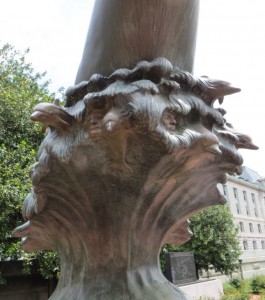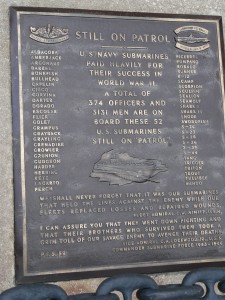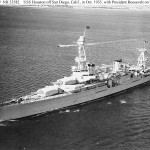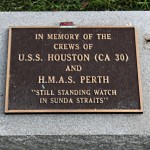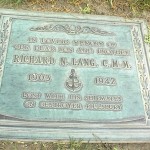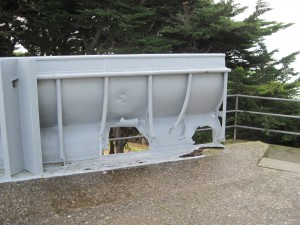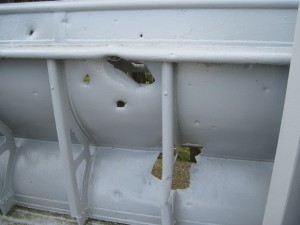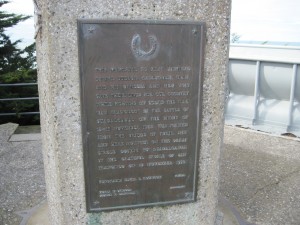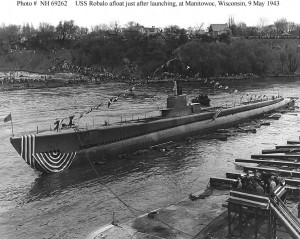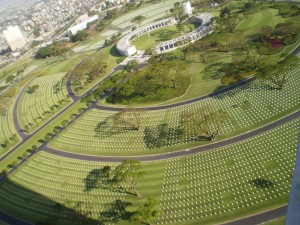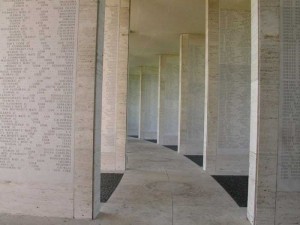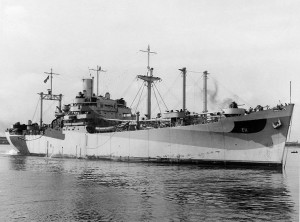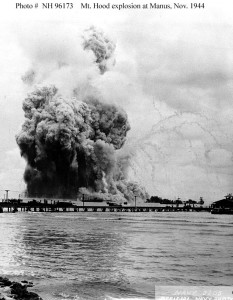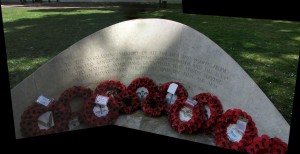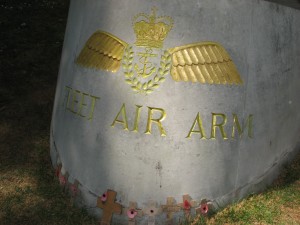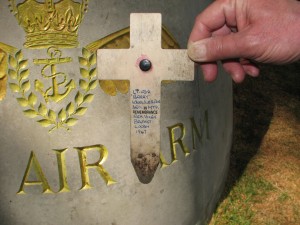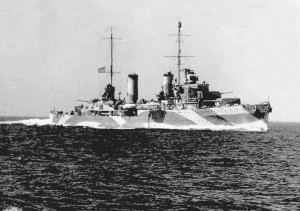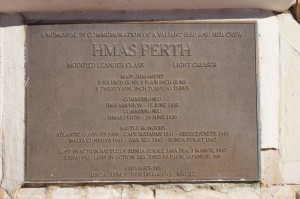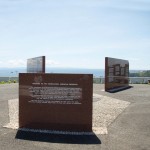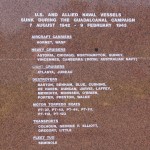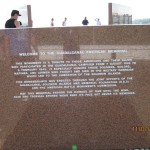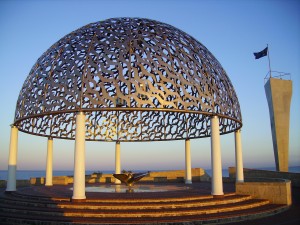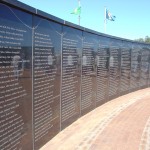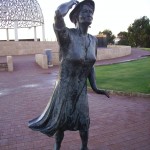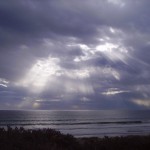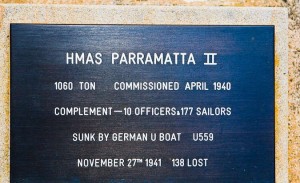Archive for the 'Wartime Naval Action' Category
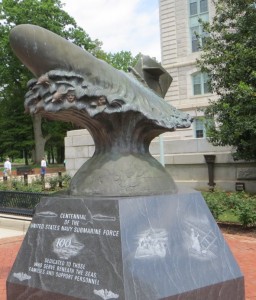 I saw this memorial to the U.S. Navy’s Submarine Service during a recent visit to the United States Naval Academy in Annapolis, Maryland. I was struck by the faces in the bow wave of the submarine – perhaps lost at sea sailors watching over living shipmates on active patrols around the world.
I saw this memorial to the U.S. Navy’s Submarine Service during a recent visit to the United States Naval Academy in Annapolis, Maryland. I was struck by the faces in the bow wave of the submarine – perhaps lost at sea sailors watching over living shipmates on active patrols around the world.
During World War II, thousands of United States Naval officers and men never returned to their home ports. Locations of some of the sunken submarines have been identified. The locations of others have never been established – and quite probably never will. The lost men are listed on various Tablets of the Missing at U.S. military cemeteries within the theater of operations where the submarines were last known to be operating. Perhaps, the spirits of all these lost men are riding the bow waves of the present submarine force – and will continue to watch their shipmates for future generations…
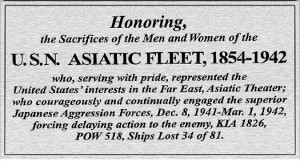 Few memorials exist to the sacrifices made by the U.S. Asiatic Fleet and their allies in the early months of 1942. Merged with British, Dutch, and Australian forces following Pearl Harbor; the ABDA fleet was outnumbered, outgunned, and outmanned. Totally unable to stop the Japanese push south in the Pacific, the fleet could only attempt to slow down the Japanese rush toward Australia. In that effort they were partially successful, but at a brutal cost. Almost 2,000 American lives were lost, thousands more wounded, and hundreds taken prisoner. Few of the prisoners would survive the war. British, Dutch and Australian losses were every bit as significant and tragic.
Few memorials exist to the sacrifices made by the U.S. Asiatic Fleet and their allies in the early months of 1942. Merged with British, Dutch, and Australian forces following Pearl Harbor; the ABDA fleet was outnumbered, outgunned, and outmanned. Totally unable to stop the Japanese push south in the Pacific, the fleet could only attempt to slow down the Japanese rush toward Australia. In that effort they were partially successful, but at a brutal cost. Almost 2,000 American lives were lost, thousands more wounded, and hundreds taken prisoner. Few of the prisoners would survive the war. British, Dutch and Australian losses were every bit as significant and tragic.
In a period of just five weeks, the combined fleet engaged the Japanese in five major battles. The first U.S. surface action of WWII was the Battle of Balikpapan on January 24, 1942. Four U.S. “four stacker” destroyers attacked a Japanese invasion fleet of over twenty ships. On February 4, 1942 the Battle of the Flores Sea was fought. The U.S.S. Marblehead (light cruiser) and the U.S.S Houston (heavy cruiser) were severely damaged. On February 19 and 20 the Battle of Badung Strait was fought. The Dutch destroyer Piet Hein was lost. On February 27 the Battle of Java Sea took place. The Dutch lost two cruisers and a destroyer and the British lost two destroyers. On February 28 came the Battle of Sunda Straight. The heavy cruiser U.S.S. Houston and the Australian light cruiser H.M.A.S. Perth fought bravely, but were overwhelmed by the superior Japanese numbers and were lost. The British cruiser Exeter was lost a few hours later. A brilliant history of this battle and the fate of the U.S.S. Houston crew can be found in James D. Hornfischer’s book Ship of Ghosts.
By the end of February 1942 all remaining allied ships were ordered to flee to Australia – the U.S. Navy Asiatic Fleet was no more.
Two other books offer brilliant accounts of the Asiatic Fleet. The best pure history is The Fleet the Gods Forgot by W.G. Winslow. The novel South to Java by Admiral William P. Mack is one of the best novels of the U.S. Navy ever written. Admiral Mack served with the Asiatic Fleet and reading his novel is almost like being there. The book has recently been re-released by The Naval Institute Press. I encourage everyone to read it.
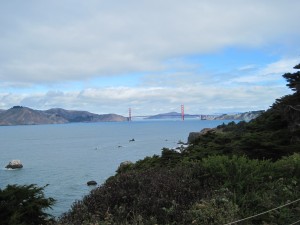 Land’s End is part of the Golden Gate National Park, located on the northwest corner of the city of San Francisco. From this stunning location one can see the entrance to San Francisco Bay, the Golden Gate Bridge, and to the west the seemingly endless stretch of the Pacific Ocean. Hundreds of warships and thousands of men departed on these waters for battle in World War II – many of the ships and men never to return.
Land’s End is part of the Golden Gate National Park, located on the northwest corner of the city of San Francisco. From this stunning location one can see the entrance to San Francisco Bay, the Golden Gate Bridge, and to the west the seemingly endless stretch of the Pacific Ocean. Hundreds of warships and thousands of men departed on these waters for battle in World War II – many of the ships and men never to return.
On the night of November 12-13, 1942 the U.S.S. San Francisco was part of what has quite often been called “the most savage close quarter naval engagement in history” off the island of Guadalcanal. The entire engagement lasted less than one hour, but numerous ships were lost and thousands lost their lives – many forever lost at sea.
The U.S.S. San Francisco survived that night to fight again in WWII. Many of her crew gave their lives that night, however. One small fact always reminds me of what horror that night must have held for the crew. During all of WWII fifty-seven (57) Medals of Honor were awarded to United States Navy personnel. On this one night alone four (4) crew members of the U.S.S. San Francisco earned the Medal of Honor – over 7% of the total awarded in the entire war. Dozens more earned the Navy Cross for bravery. Virtually the entire crew earned the Purple Heart.
The U.S.S. San Francisco Memorial is located at Land’s End. The memorial consists of various plaques and small memorials attached to an actual surviving section of the ship. The Bridge Wings of the ship (armor meant to protect the bridge) are permanently on display at the memorial. Standing inside the bridge wings and counting the shell holes is a sobering experience. Shells came from every direction – generally entering one side of the bridge wings, going through the bridge itself, and then exiting the other side of the bridge wings. It’s hard to comprehend how any living thing could survive on the bridge – yet they did.
Please visit the web site for the U.S.S. San Francisco Memorial at http://www.usssanfrancisco.org/. There you will find a history of the ship, the memorial itself, and best of all many stories of her crew.
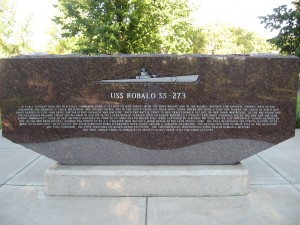 This graceful memorial is dedicated to the WWII submarine U.S.S. Robalo (SS-273). Robalo was a Gato-class submarine built in Manitowoc, Wisconsin and launched on May 9, 1943. The memorial is located in Lindenwood Park on Roger Maris Drive in Fargo, North Dakota.
This graceful memorial is dedicated to the WWII submarine U.S.S. Robalo (SS-273). Robalo was a Gato-class submarine built in Manitowoc, Wisconsin and launched on May 9, 1943. The memorial is located in Lindenwood Park on Roger Maris Drive in Fargo, North Dakota.
After the end of World War II, the U.S. Submarine Veterans of WWII assigned each of the 52 submarines lost during the war to a state. It was hoped that appropriate memorials would be constructed by each state to their assigned submarine. While most states have not constructed memorials, some have. This is one of my favorites. On the back of the memorial are the names of all the crew members lost at sea on the Robalo. The front of the memorial contains a brief history of the ship, which I quote below:
“USS Robalo SS – 273. In early January 1944, the new fleet submarine Robalo set out to join forces with the ships raging war in the Pacific. Hunting for Japanese shipping west of the Philippines, she damaged a large freighter. Her second patrol was in the South China Sea near Indo-China, where she sank a 7,500 ton tanker, the cargo of which was badly needed to fuel and drive the far flung Japanese war machine. With two battle stars to her credit, Robalo set out on her third war patrol. As she was transiting the hazardous Balabac Strait off Palawan Island on 26 July 1944, Robalo strayed into an enemy minefield. A violent explosion suddenly jolted the ship and she sank almost immediately. Four of her crewmen managed to swim to Palawan Island where they were captured by Japanese military police and imprisoned. A note dropped by one of the men in his cell window was picked up by a US soldier who was on a work detail in the same prison camp. The note recounted the events leading up to Robalo’s tragic loss. On 15 August, the four surviving Robalo crewmen were taken aboard a Japanese destroyer. The destination and ultimate fate of the destroyer are still unknown. The four survivors on board never returned. The circumstances surrounding their deaths remain a mystery, but they joined their 77 shipmates in bravely giving their lives for their country.”
Joining the monument is a marker with the names of the North Dakota submariners and polished stone benches with the names of Commander Harold Wright, Captain Joseph Enright, and Lieutenant Commander Verne Skjonsby, all North Dakota residents who served on submarines during WWII.
This post gives me the opportunity to encourage all readers to visit one of my favorite web sites, On Eternal Patrol: http://www.oneternalpatrol.com/
Contained within this amazing web site is the history of every United States Navy submarine lost during the Second World War, listings of all the crew members lost at sea, photographs of hundreds of those lost, and links to a number of fascinating web sites detailing the history of the silent service. This is a web site not to be missed.
Over 32,000 U.S. Navy sailors were lost at sea from late 1941 through 1945. Over 10% of those were lost on submarines. The U.S.S. Robalo was only one of fifty-two American submarines never to return to port, one of thousands of ships from hundreds of nations on eternal patrol…
A sobering element of any American military cemetery on foreign soil is The Tablets of the Missing – a listing of the dead with no known graves. These listings always include thousands lost at sea.
The American Military Cemetery and Memorial in Manila is the largest American military cemetery on foreign soil. Over 17,000 graves are arranged in a circular layout encompassing 125 acres. Constructed in the middle are two hemicycles, listing a staggering 36,282 names of Americans who lost their lives in the South Pacific during WWII and have no known resting place. I first visited this site in the early 1970s. The scope of the collective sacrifice forever resting within this beautiful and peaceful place took my breath away – an emotion that remains with me today.
On that first visit I randomly jotted down the names of a few men on the Tablets of the Missing, hoping to eventually ‘humanize’ the experience somehow – to learn more about these men and the actions where they lost their lives. Years later I was able to determine that one of the names I jotted down was lost on the U.S.S Mount Hood (AE-11).
The Mount Hood was an ammunition ship that exploded due to unknown causes on November 10, 1944 while anchored in Seeadler Harbour at Manus Island (Admiralty Islands). The explosion killed all 295 men aboard and severely damaged 22 other ships in the harbor. The repair ship U.S.S. Mindanao was alongside Mount Hood when the explosion occurred. 82 of the Mindanao crew also died that day. 371 sailors on other ships in the harbor were injured. An investigation board was never able to ascertain the exact cause of the accident, but it was not due to combat. War is a dangerous business – and all casualties are not due to combat. Whether by combat or accident, the loss is felt just as strongly by family, friends and shipmates.
While researching the history of the U.S.S. Mount Hood, I came across a beautiful YouTube tribute from a niece to an uncle she never knew. Seaman Second Class J.C. McGuire of Alabama died on November 10, 1944 while stationed aboard the Mount Hood. His remains were never recovered. He was eighteen when he died. Please take the time to view the short video. It puts a very human face to a name forever engraved on a marble wall so far from the home he left during WWII.
http://www.youtube.com/watch?v=c6UtLYybM8I
 In the Victoria Embankment Gardens along the river Thames in London is a memorial to the Fleet Air Arm of the Royal Navy. The memorial is a striking bronze figure of Daedalus, the ingenious craftsman of Greek legend who created wings to escape King Minos of Crete, only to lose his son Icarus when he flew too close to the sun and his wings melted. Icarus plunged into the sea…
In the Victoria Embankment Gardens along the river Thames in London is a memorial to the Fleet Air Arm of the Royal Navy. The memorial is a striking bronze figure of Daedalus, the ingenious craftsman of Greek legend who created wings to escape King Minos of Crete, only to lose his son Icarus when he flew too close to the sun and his wings melted. Icarus plunged into the sea…
The memorial was designed by Royal Academy artist and sculptor James Butler as a tribute to the more than 6,000 individuals who have given their lives in Royal Navy Air Service since World War I – 1,925 of whom have no graves except the oceans of the world.
Butler’s own words best describe the power of the statue: “I wanted Daedalus to appear mighty, strong and capable, a man and yet half machine, with wings which are an integral part of him and yet still clearly man-made and fastened crudely to his arms. He must have an air of tragedy in his countenance, after all he is mourning the death of his colleagues. With his arms outspread in this position and his head slightly bowed, there are suggestions of crucifixion which signal the sacrifice of the brave men and women in their Naval Service over the years.”
When I saw the statue a few weeks ago on a visit to London with my wife, I noticed some very small, individual tributes left at the base. One was a small wooden cross in memory of “Lt. Commander ‘Barry’ Knowles, RN”. I did some research on Commander Knowles on my return to the United States. David Barry Knowles and his crew mate Ian E. Shaw were lost in the crash of a Sea Vixen aircraft in the Irish Sea on December 4, 1967. The Sea Vixen was a beautiful but exceptionally unforgiving aircraft operated by the Royal Navy off their aircraft carriers for over a decade. Almost 60 Royal Navy aviators lost their lives flying the Sea Vixen.
The Fleet Air Arm Memorial is a truly moving and powerful symbol of the sacrifices of David Barry Knowles, Ian Shaw, and the thousands of others who gave so very much in the service of their country…
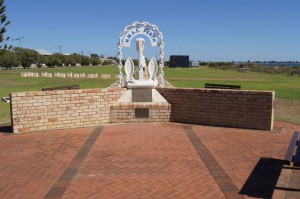 The names of honored Australian warships can sound like the reading of names of Australia’s most prominent cities from a map – Sydney, Canberra, Perth. These beautiful cities personify the swagger and pride of all Australians. But add the simple preface phrase His Majesty’s Australian Ship to those famous city names and a somewhat different image results – an image of bravery, dedication, sacrifice, suffering, and loss. During World War II the sacrifices of the Royal Australian Navy and her brave sailors were second to none.
The names of honored Australian warships can sound like the reading of names of Australia’s most prominent cities from a map – Sydney, Canberra, Perth. These beautiful cities personify the swagger and pride of all Australians. But add the simple preface phrase His Majesty’s Australian Ship to those famous city names and a somewhat different image results – an image of bravery, dedication, sacrifice, suffering, and loss. During World War II the sacrifices of the Royal Australian Navy and her brave sailors were second to none.
A previous post on this blog covered the HMAS Sydney and the stunning memorial to her memory. The HMAS Canberra was lost off of Guadalcanal in 1942 in the Battle of Savo Island. The United States Navy named a ship in her memory – the only U.S. Naval ship ever named after the ship of another country. Such was the esteem the Americans held for her sacrifice.
HMAS Perth also had a distinguished career and a tragic end. Built in 1936 at the Portsmouth Naval Dockyard in England, the Leander class light cruiser was acquired by the Royal Australian Navy in 1939. Early in WWII she saw action in the Mediterranean Theater of War – supporting actions in Greece, Crete and Syria. In early 1942 she was transferred to waters closer to home.
On February 14, 1942 HMAS Perth and the USS Houston were the only large Allied ships to survive the Battle of the Java Sea. After the battle the two ships attempted to resupply, but fuel and ammunition shortages left both cruisers critically short of shells and fuel when both were ordered to sail for Yjilatjap via the Sunda Straight two weeks later. Shortly after midnight on March 1, 1942 both ships were attacked by a superior Japanese naval force in the Sunda Straight. HMAS Perth was hit by four enemy torpedoes and was lost. USS Houston was sunk a short time later.
353 of HMAS Perth’s crew of 682 died on the night of the Battle of Sunda Straight – almost all lost at sea. Of the 329 survivors, most were taken prisoner – sent to live and die in yet another hell, as forced labor in the building of the Burma Railroad made infamous in the book and movie “The Bridge on the River Kwai”. Only 218 of HMAS Perth’s original crew were repatriated after the war.
Those interested in the Battle of Sunda Straight and the Allied survivors later ordeals in Burma are encouraged to read Australian writer Mike Carlton’s fine book Cruiser about the HMAS Perth and James D. Hornfischer’s equally fine work Ship of Ghosts, detailing the story of the USS Houston.
The Sunda Straight is the tropical body of water separating the islands of Sumatra and Java. It is the final resting place of hundreds of brave sailors from His Majesty’s Australian Ship Perth…
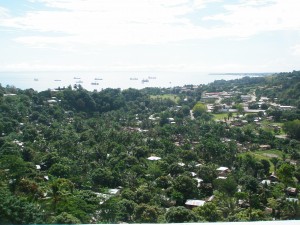 On a hill overlooking the beautiful and tranquil Pacific Ocean in Honiara, Solomon Islands stands an American Monument to the Naval and Marine Corps nightmare known as Guadalcanal. The first major United States Pacific offensive of WWII was ultimately successful, but at a cost that was horrific. Twenty-four U.S. naval vessels were lost – aircraft carriers, heavy cruisers, light cruisers, and destroyers. Their names echo in American naval history – Astoria, Hornet, Wasp, Atlanta, Cushing, Porter, Preston, Juneau, and on and on. The human cost was even higher – 1,592 Marine and Army troops and airmen killed in action – 5,041 U.S. Naval officers and sailors killed, most of those lost at sea in some of the most heroic and brutal naval combat in human history. One must add to that total the thousands of equally brave Japanese and Australians who also gave their lives in 1942 and 1943 in the tropical waters off Guadalcanal that came to be known as “Ironbottom Sound” to those who survived the carnage.
On a hill overlooking the beautiful and tranquil Pacific Ocean in Honiara, Solomon Islands stands an American Monument to the Naval and Marine Corps nightmare known as Guadalcanal. The first major United States Pacific offensive of WWII was ultimately successful, but at a cost that was horrific. Twenty-four U.S. naval vessels were lost – aircraft carriers, heavy cruisers, light cruisers, and destroyers. Their names echo in American naval history – Astoria, Hornet, Wasp, Atlanta, Cushing, Porter, Preston, Juneau, and on and on. The human cost was even higher – 1,592 Marine and Army troops and airmen killed in action – 5,041 U.S. Naval officers and sailors killed, most of those lost at sea in some of the most heroic and brutal naval combat in human history. One must add to that total the thousands of equally brave Japanese and Australians who also gave their lives in 1942 and 1943 in the tropical waters off Guadalcanal that came to be known as “Ironbottom Sound” to those who survived the carnage.
It’s been almost seven decades now – the brutality and death of the Battles of Cape Esperance and Savo Island and Tassafaronga have been replaced by the lush green background of the Solomon Island hills – and the once blood-stained waters washed clean by a deep calming blue marking the common resting place of men once mortal enemies, now resting together in peace. The words of Joseph Conrad were perhaps meant for this very place more than any other…
“May the deep where he sleeps rock him gently, gently, until the end of time.”
I encourage every reader of this blog to read James D. Hornfischer’s book “Neptune’s Inferno” to learn much more about the U.S. Navy at Guadalcanal. It is superb history, written by a master of the English language.
Many of the facts concerning the deadly encounter of the HMAS Sydney II and the HSK Kormoran on a November night in 1941 remained a mystery for almost six decades. Even the discovery of the wrecks of both ships in 2008 did not answer every question. Those remaining secrets will forever rest with the hundreds of souls who died that night off the coast of Western Australia. What is known can be researched and contemplated by reading through a number of superb Internet sites maintained by the Australian government and private foundations. I will attach links to many of these sites – as well as a link to the talented artists who created this most beautiful and uplifting memorial.
During WWI and WWII the German Navy employed Raiders with some success. Raiders were basically merchant or passenger ships converted to fully functioning warships, but maintaining the silhouettes of the original vessel. Weapons (guns, mines and torpedoes) were disguised, as were the name and country of origin of the raiders. The HSK Kormoran in late 1941 was disguised as the Dutch freighter Straat Malakka as she carried out her orders to lay mines and sink Allied merchant ships in the Indian Ocean.
HMAS Sydney II was a Leander Class light cruiser built in Great Britain and launched in 1934. In late 1941 she was patrolling the waters off Western Australia. On the night of November 19, 1941 she intercepted the German Raider Kormoran. The time from the moment that the two ships first sighted each other to the end of the engagement constituted less than two hours. Shortly after the engagement was over both ships lay at the bottom of the Indian Ocean. The Kormoran lost 82 souls to the ocean depths – 318 of her crew survived and were rescued by the Australians. The toll on the Sydney II was unimaginable – 645 lost at sea – the entire crew. The Royal Australian Navy has a long and glorious history. The loss of the HMAS Sydney II remains its greatest tragedy. Over six decades there has been much written questioning how a fully-armed Australian warship could have been lost with all souls to a German Raider that would have had to keep her actual identity and intentions secret until the last possible minute. Please click on the links at the end of this post if you wish to read more about this subject. My feeling is that it was combination of bad judgement and bad fortune for the Sydney – and quite the opposite for the Kormoran. The wreckage of the Sydney most certainly reveals that her loss was due to a devastating explosion some hours after the battle had ended – the explosion cutting the ship in half.
The HMAS Sydney II Memorial in Geraldton, Australia is one of my favorites. Incorporated within this extensive memorial are nautical themes, the pain of survivors, and a tribute to the dead that envelops and surrounds the visitor.
The artists who conceived and built this memorial are husband and wife Charles Smith and Joan Walsh-Smith. Originally from Ireland, they settled in Western Australia in 1984. Their web site devoted to the design and construction of the memorial can be found at: http://www.hmassydneymemorialgeraldton.com.au/
The memorial has several elements:
- The Dome of Souls: This is a most appealing structure within the memorial complex. The dome consists of 645 seagulls, one for each member of the Sydney crew lost on that fateful night.
- The Podium: The area underneath the dome, done in beautiful mosaic, with a ship’s propeller as the centerpiece.
- The Stele: A representation of the Sydney’s bow section.
- The Waiting Woman: A statue of a women looking out to the Indian Ocean – silently waiting for a loved one who will never return.
- The Wall of Remembrance: A history of the ship and a listing of the names, rates & ranks, and birthplaces of the dead. The wall ends with the inscription “The Rest is Silence”.
I understand plans are underway for an additional element called The Pool of Remembrance. At the bottom of the pool will be a map showing the final resting places of the Sydney and Kormoran.
Please visit the following links for more detailed information on the battle and the aftermath:
The Western Australian Museum: http://wamuseum.com.au/sydney/
The Finding Sydney Foundation: http://www.findingsydney.com/
The HMAS Sydney II Memorial Site: http://www.sydneymemorial.com/
The beautiful photographs of the memorial and Indian Ocean southwest of the memorial were taken by Michael Lawrence Sofoulis (Spider52 on Panoramio, the Google Earth Photo Site). In his email that granted me permission to use his work on this post, Michael related that he was named after an uncle, Michael Nicholas Sofoulis, who was lost at sea in the sinking of the HMAS Parramatta II off Tobruk (North Africa) by the German submarine U-559. Michael Nicholas Sofoulis was 19 years old when he gave his life for his country on November 27, 1941, exactly 8 days after 645 of his countrymen sacrificed their futures on the Sydney. The Geraldton memorial is dedicated to the memory of the crew of the Sydney, but The Dome of Souls and The Waiting Woman most certainly reflect the value placed on every Australian lost at sea in war – whether on the Sydney, the Parramatta II, the Waterhen, the nurses lost on the Vyner Brooke or even the ANZAC troops lost off the shores of Gallipoli a generation before 1941. The Seven Seas contain the resting places of untold numbers of brave Australians, who sailed from home for distant shores and an unknown fate. The seagulls of the Sydney memorial fly eternally for them all…
